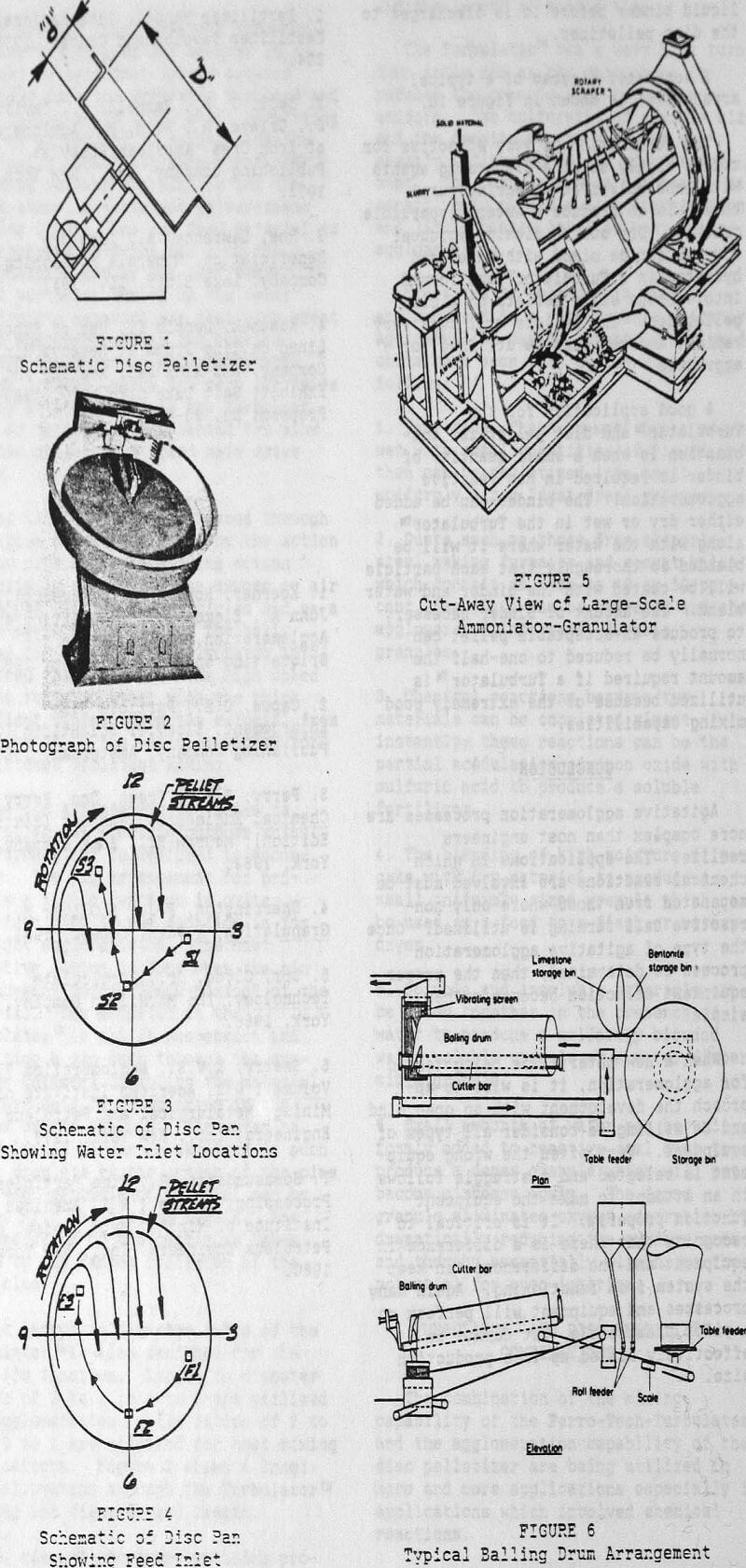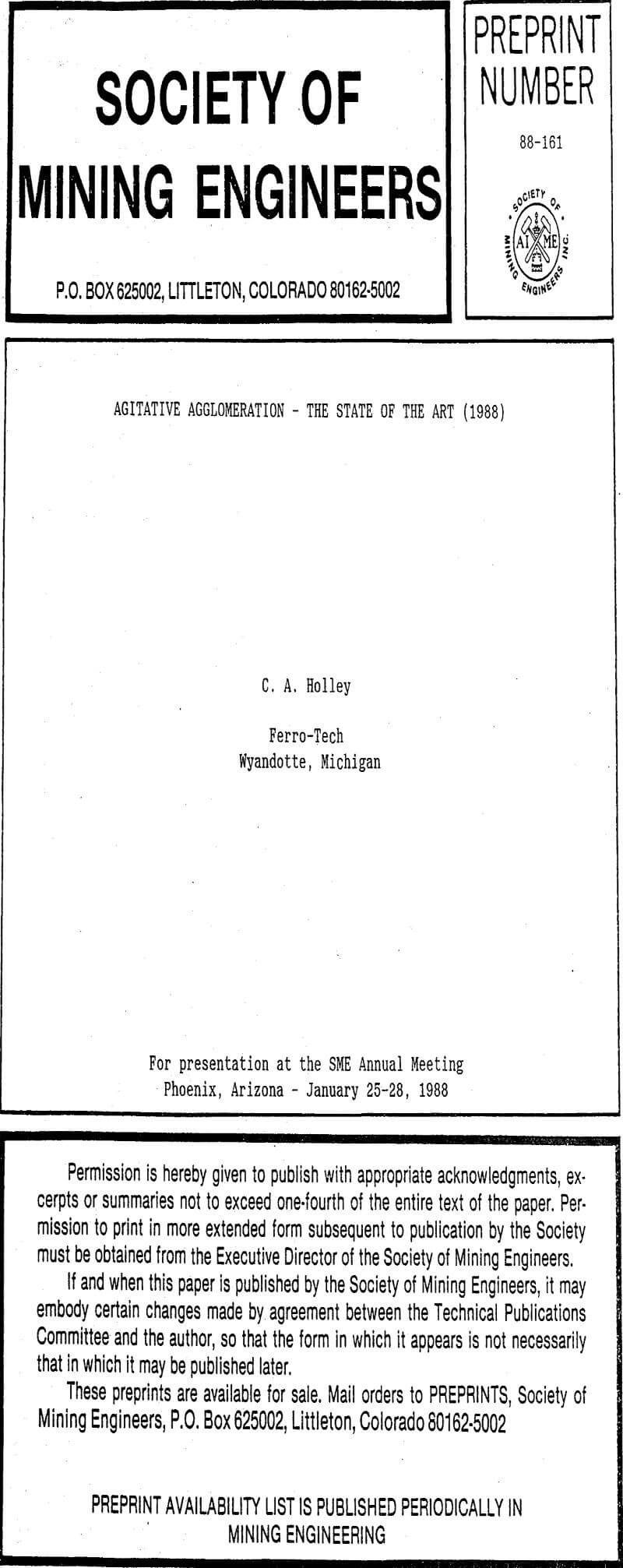Table of Contents
Agitative agglomeration is the process of the consolidation of particles into larger shapes by means of agitation with a liquid. Most fine powders can readily be formed into granular masses by admixture with a liquid and by utilizing a suitable agitation method. Ideally, each particle should be coated with the liquid by stirring or moving the particles forcefully. The most common liquid is water which has a very high surface tension so the capillary binding forces may be utilized as the primary force to hold the agglomerates together. To produce strong agglomerates, the size and size distribution of the individual particles making up powder must be such that they will have a good packing density.
Non-Reactive Pellet Forming. Iron ore processing is the largest tonnage of material being pelletized by agitative agglomeration in which there is no chemical reaction between the particles and the liquid. Since it is a large tonnage product and since it is easy to study, much investigation has been done regarding this type of the ball formation. Other materials which are normally non-reactive are coal, cement raw mix, agricultural chemicals, limestone, graphite, organic fertilizer, carbon black, coal dust, clay and grain dust.
Reactive Pellet-Forming. By far, the largest group of materials formed into pellets by agitative agglomeration methods have a chemical reaction between the powdered material and the liquid.
The manufacture of granular ammonium phosphate sulfate (NPK) fertilizer was the first large scale utilization of a chemical reaction to produce a pellet. In this process a blend of potash, ammonium sulfate and super phosphate was placed into a drum or paddle mixer and reacted with phosphoric acid, sulfuric acid and liquid ammonia. By trial and error, the formulations for each grade fertilizer were adjusted to provide the proper reaction at the lowest cost.
Disc Pelletizer
The shallow pan disc pelletizer or disc pelletizer is the most versatile of the agitative agglomeration devices. The use of the inclined pan pelletizer has been known for a long time with the first patents being issued well before the turn of the century.
Lurgi and Dravo Corporation stimulated the use of the disc pelletizer in iron ore pelletizing plants to produce a uniformly sized pellet which could be indurated. Since strong and uniformly sized pellets were very important to the iron ore industry, much financial support was given to study the art of “balling” and ball formation. At approximately the same time, Allis Chalmers was utilizing the disc pelletizer in cement and other industries for use as part of its grate-kiln process.
Drums
The use of drums for agglomeration or granulation began in the fertilizer industry as an improvement in the 1920’s over other batch mixers for blending dry ingredients. The batch process was slow and produced inconsistent results so a continuous open drum was utilized. The most common granulator for the “steam granulation” process was a horizontal drum with a restraining ring at the feed end. The granulation is controlled by the amounts of steam and water added to each blend of fertilizer. Many blends of materials were utilized and each blend was a separate chemical and agglomeration process. Most of the plants utilized salts dissolved in the water as the “liquid phase” and in order to hold more salts, the water was usually heated.
The early fertilizer granulation was primarily a non-reactive process utilizing the deposited salts as the binder. The ammoniation of triple superphosphate soon began and with it the desire for the mixing, chemical reaction and granulation to be done in one drum.
Spherodizer
The Spherodizer, a proprietary device developed by C&I Girdler is used for granulating and drying slurries. The neutralized slurry containing potash is sprayed against a falling curtain of solid particles in a rotary drum. Heated air for drying is blown in concurrently to the spray. Typical inlet air temperature is 350° F to 400° F. Since the granules cycle through the sprays many times before they leave the drum, a layering type of granulation and rapid evaporation of water is obtained. Most of the granules leaving the drum are on-size with the off-size fines being recycled. The process produces closely sized, well rounded, hard granules which are generally considered to be of excellent quality.
Iron Ore
The idea of rolling moist fine ore in a drum to form balls and then drying and firing these balls was first put forward by Andersson in Sweden. His patents- taken out in 1913 was never used commercially and his work was forgotten. H. J. Stehli of the Dwight-Lloyd Company and J. E. Greenwalt experimented in the early 1920’s with pellet formation by the drum rolling method. In 1948, a pilot plant owned by Erie Mining Company began operation utilizing a drum pelletizer to produce taconite pellets.
The balling drum circuit for iron ore is shown in its simplest form in Figure 6. The circuit consists of the rotating drum, which has a length-to-diameter ratio of 2.5 to 3.5, a vibrating screen and a recycle belt conveyor. Since there is no classification capability in the drum, it is important to have the seed material and a conditioned feed before balling will take place. The drum loading or the amount of material in residence in the drum to give the required rolling action varies with the material being processed and is usually very low, equivalent to about 5% of the drum volume. The drum operation is restricted by the need to satisfy three constraints: the speed of rotation, the depth of material in residence in the drum and the time required for balling. The output from a drum can be increased by increasing the diameter or the length of the drum or both. Once the diameter and the length are fixed, the drum speed and the bed depth are restricted to fairly narrow limits. It is the normal practice to operate by altering both the feed rate and the drum speed.
Pin Agglomerator
After some 15 years of development, the Ferro-Tech-Turbulator has evolved as a very unique and versatile agitative agglomeration device. This agglomerator has maximum efficiency because it operates by fluidizing the powder and atomizing the liquid binder. Each whirling fine particle of powder is uniformly coated with a very thin layer of liquid binder. These coated fine particles moving at a high velocity in suspension collide and impact with great force with other coated spinning particles within the turbulent wake created behind the pins, forming a very uniformly sized and dense particulate or microgranule. The thick resilient polymer liner with critically close pin tip tolerance fully sweep or wipe the liner, eliminating product build-up on the inner casing of the agglomerator body. Because of the intensity of the action, the Turbulator can efficiently pre-blend, de-dust, blend, condition, densify, hydrate and micropelletize all types of fine powders, dust, fume and hard-to-wet particulates.



